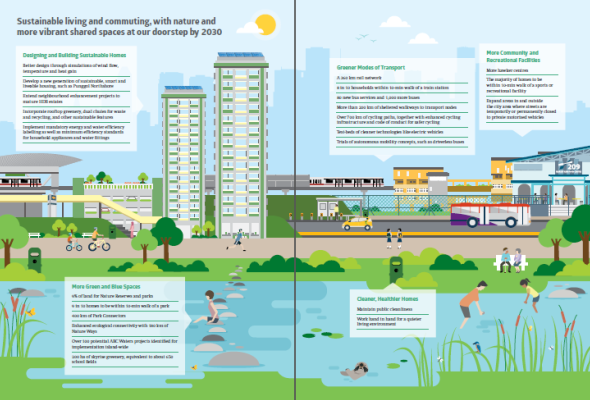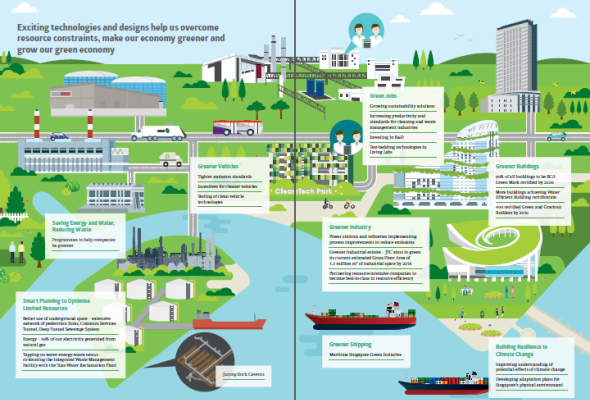 The annual Clean and Green Singapore held over the weekend saw the release of the Sustainable Singapore Blueprint 2015, which is revised and updated from the previous blueprint published in 2009.
The annual Clean and Green Singapore held over the weekend saw the release of the Sustainable Singapore Blueprint 2015, which is revised and updated from the previous blueprint published in 2009.
The Sustainable Singapore Blueprint 2015 outlines our national vision and plans for a more liveable and sustainable Singapore, and is broadly divided into 3 key areas:
- A Liveable and Endearing Home
- A Vibrant and Sustainable City
- An Active and Gracious Community
A Liveable and Endearing Home
The blueprint highlights the efforts to create more sustainable housing estates, with new HDB flats having Pneumatic Waste Conveyance Systems, solar panels, centralised chutes for recyclables, rainwater harvesting, rooftop greenery, and elevator energy regeneration systems. Sustainable features will also be introduced to existing HDB estates through the HDB Greenprint programme.
Energy and water labelling and minimum standards for home appliances and water fittings would also help residents save energy and water at home.
Public transport will be encouraged with the aim to increase the public transport mode share during peak periods to 75% by 2030. Cycling and carsharing will also be promoted.
There will be more green and blue spaces near our homes, with the target to increase this accessibility to more than 90% of households by 2030. Our park connector network will also be doubled to 400km by 2030.
A Vibrant and Sustainable City
Singapore will continue to optimise land through an integrated planning process, decentralise jobs from the Central Business District to regional commercial centres, and explore greater use of underground spaces.
By 2060, NEWater can meet up to 55% of our water demand, and desalination can meet up to 25% of our water demand.
More than 90% of Singapore’s electricity is generated using natural gas, and our LNG terminals will allow us to diversify our sources. Singapore will also continue to take proactive steps to support solar deployment.
Singapore will work towards becoming a Zero Waste Nation by reducing our consumption, reusing and recycling all materials. Singapore has set a national recycling rate target of 70% in 2030, with the increase in domestic recycling rate from 20% in 2013 to 30% in 2030, and the increase for non-domestic recycling rate from 77% in 2013 to 81% in 2030.
More initiatives will be introduced to reduce food waste in Food and Beverage businesses and to improve the recycling of electrical and electronic waste.
Singapore is co-locating its new Integrated Waste Management Facility with the Tuas Water Reclamation Plant to optimise land use and realise process synergies in the water-energy-waste nexus. Situated in Tuas, both the facilities are expected to be completed by 2024.
An ecosystem of supporting infrastructure and policies will help local businesses reduce resource consumption, carbon emissions and waste generated.
The BCA Green Mark scheme helps to evaluate a building’s environmental impact and recognise its sustainability performance. Singapore’s target is for 80% of buildings to achieve the standards of Green Mark by 2030.
Greener vehicles are encouraged through new or higher emissions standards for vehicles, the Carbon Emissions-based Vehicle Scheme and the Fuel Economy Labelling Scheme.
Singapore is committed to greener shipping as a major hub port, and has introduced the Maritime Singapore Green Initiative, which includes incentivising ship owners to adopt energy efficient ship designs or scrubber technologies, encouraging ocean-going ships to reduce the emissions of pollutants, and providing grants to local maritime companies to develop and adopt green technologies.
Singapore is also acting now to future-proof our city against the potential impacts of climate change, with adaptation planning guided by a Resilience Framework.
An Active and Gracious Community
Singapore will continue to encourage environmental education in schools, engage the community through various green events, encourage more green volunteers, and make better use of crowdsourcing to draw innovative ideas from the community. CDCs have also developed green plans and targets for their own districts.
Companies are encouraged to benchmark the environmental impact of their activities with other companies through sustainability reporting.
The Public Sector Taking the Lead in Environmental Sustainability (PSTLES) initiative was introduced in 2006 to improve resource efficiency within the public sector. Under a new PSTLES 2.0, agencies will set more ambitious targets for resource efficiency and put in place better organisational processes to help achieve these targets. In each Ministry, a Sustainability Manager will coordinate efforts within the Ministry and with its Statutory Boards and share good practices through a Sustainability Manager network. Agencies will develop and submit plans on how to achieve their sustainability targets. The public sector will share its progress through a Public Sector Sustainability Report every 3 years.
Our Thoughts
We would give a B grade for the Sustainable Singapore Blueprint 2015 for covering Singapore’s comprehensive plans for liveability and sustainability.
We like the plans for developing more sustainable housing and green buildings; meeting our water needs; increasing the use of solar; increasing the use of public transport, cycling and carsharing; more efforts on waste reduction and recycling; and the public sector doing more through PSTLES 2.0.
Maybe the blueprint could address these 3 points for further improvements and to get an A grade:
1) Consider our consumption and the impacts
(e.g. buying less, using less disposables, choosing green products, supporting green business models, etc)
2) Set more ambitious policies and targets for certain issues
(e.g. domestic waste target, waste reduction and reuse, green businesses, sustainable procurement, etc)
3) Shift the focus on technological/big/costly/top-down solutions to awareness/behaviour/experimental/bottom-up solutions
(e.g. behaviour observation and analysis, policy experimentation, design thinking, lean principles, involving the community on project design and implementation, regular deep conversations with stakeholders, etc)
What do you think of the revised Sustainable Singapore Blueprint? Share your thoughts with us!
Source and images credit: Sustainable Singapore Blueprint 2015, MEWR and MND




2 thoughts on “Sustainable Singapore Blueprint 2015 – Highlights and Thoughts”